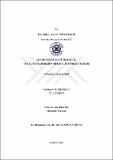Please use this identifier to cite or link to this item:
http://hdl.handle.net/11547/2367Full metadata record
| DC Field | Value | Language |
|---|---|---|
| dc.contributor.author | Velibeyoğlu, Veli Rauf | - |
| dc.date.accessioned | 2019-05-30T07:06:59Z | - |
| dc.date.available | 2019-05-30T07:06:59Z | - |
| dc.date.issued | 2018 | - |
| dc.identifier.uri | http://hdl.handle.net/11547/2367 | - |
| dc.description.abstract | Bu tez çalışmasında, Avrupa tarihindeki totaliter rejimlerin, mimariyi kendi ideolojileri doğrultusunda nasıl kullandıkları ele alınmıştır. Bu yüzden öncelikle ideoloji, erk, politika, totalitarizm, propaganda ve ütopya kavramları incelenecek, ardından bu kavramların mimarlık disipliniyle olan ilişkileri ortaya koyulup, hepsi tek bir başlık altında analiz edilecektir. Kavramsal terimler ve bu terimlerin mimariyle ilişkiler incelendikten sonra, önce totaliter rejim mimarilerine ilham veren dönemler, sırasıyla Büyük İskender devrindeki Helenistik Dönem, İmparator Augustus Dönemi Roma’sı ve Napoléon Dönemi’nde icra edilen mimariler incelenecek ve ardından da tezin asıl konusu olan totaliter rejim mimarileri, bu bahsedilen dönemlerden sonra sırasıyla Mussolini, Hitler ve Stalin dönemleri olarak analiz edilecektir. Bu araştırma konusunun seçilmesinin sebebi, mimarlığın tarihteki en önemli totaliter erklerin elinde, ideolojik hedefler doğrultusunda avama yönelik nasıl bir propaganda aracına dönüştürüldüğünün yanı sıra, mimarinin aslında sanat ve mühendislik yönünün dışında, ne gibi bir sosyolojik etki sahası ve kullanımı olduğunu ortaya koymak olmuştur. Mimarlık sanat özelliği taşımasının dışında mimarlık, egemen siyasal ideolojiler tarafından bir erk gösterisi ve propaganda amacıyla manipüle edilip kullanılmıştır ve günümüzde halen kullanılmaktadır. Avrupa totaliter rejimleri, benzer basmakalıp siyasi faaliyetleri kullanarak, egemen oldukları kitlelerle hem aralarında bir bağ kurmak için, hem siyasi ideolojilerini meşru kılmak için, hem de propaganda teknikleriyle halkın algısını kontrol edip yönetebilmek için, mimarlık disiplinini kendi ideolojik hedefleri doğrultusunda bir araç olarak kullanmışlardır. Mimarinin bu ideolojik kavramlarla olan ilişkisi, en ufak kamu yapılarından kent ölçeğine kadar gözlemlenebilmektedir. Çünkü egemen erkin ideolojisini ve yaşam tarzını yansıtacak şekilde yenilenen kent çehreleri, fiziksel ortamda yaşam bulan sembolik ve ideolojik anıtlara dönüşürler. Aslında bütün bu mimari süreç, otoriteyi elinde tutan gücün, kent ölçeğinde tasarladığı bir ideolojik kurgudan ibarettir. Egemen erk tarafından mimari ile kurulmuş bu ideolojik kurgu ortamında yaşayan toplum, algısı yönetilen bir kitle haline gelir. Dolayısıyla mimarlar, tarih boyunca kimi zaman isteyerek, kimi zaman da istemeden egemen siyasal erkle gizli bir ilişki içerisinde olmuşlardır. Bu ilişkiye karşı çıkanlar da, var olma mücadelesi içine düşmüşlerdir. Günümüzde bu ilişki, hiç bozulmadan devam etmektedir. | tr_TR |
| dc.language.iso | tr | tr_TR |
| dc.publisher | İSTANBUL AYDIN ÜNİVERSİTESİ FEN BİLİMLERİ ENSTİTÜSÜ | tr_TR |
| dc.subject | Mimari | tr_TR |
| dc.subject | Totalitarizm | tr_TR |
| dc.subject | Erk | tr_TR |
| dc.subject | İdeoloji | tr_TR |
| dc.subject | Propaganda | tr_TR |
| dc.subject | Architecture | tr_TR |
| dc.subject | Totalitarism | tr_TR |
| dc.subject | Power | tr_TR |
| dc.subject | Ideology | tr_TR |
| dc.subject | Propaganda | tr_TR |
| dc.title | EGEMEN İDEOLOJİ VE MİMARLIK: TOTALİTER REJİMLERİN MİMARİ ÜZERİNDEKİ ETKİLERİ | tr_TR |
| dc.type | Thesis | tr_TR |
| dc.description.abstractol | In this thesis, it is discussed how the totalitarian regimes of Europe used architecture in the direction of their own ideologies. Therefore, the concepts of ideology, power, politics, totalitarianism, propaganda and utopia will be examined first, then the relations of these concepts with the discipline of architecture will be revealed and analyzed under a single heading. After examining the conceptual terms and their relation with the architecture, the periods that inspired the architecture of the totalitarian regime, the Hellenistic period during the Great Alexander era, the Roman period of the Emperor Augustus period and the architects practiced during the Napoleonic period, will be examined. And then the totalitarian regime architects, which are the main theme of the thesis, will be analyzed as Mussolini, Hitler and Stalin periods respectively after these mentioned periods. The reason for the selection of this research topic was to reveal how architecture was transformed into a propaganda towards the ideological goals in the hands of the most important totalitarian powers in history, as well as what kind of sociological impact and use of architecture is beyond its art and engineering direction. Architecture is the name given to the art of building places where people’s vital activities go. However, apart from the artistic feature, architecture has been manipulated and used by ruling political ideologies for the sake of power and propaganda, is still being used today. European totalitarian regimes have used architectural discipline as a tool for their own ideological goals to establish a bond among themselves, to legitimize political ideologies, and to control and manipulate people’s perception through propaganda techniques, using similar stereotypical political activities. The relationship of the architect with these ideological concepts can be observed from the smallest public constructions to the urban scale. So architectural discipline and architects are a means of serving and enlisting the political power. Because the urban façades, which have been renewed to reflect the ideology and lifestyle of the ruling elder, turn into symbolic and ideological monuments that live in the physical environment. In fact, all this architectural process is an ideological fiction designed by the power of the city, which holds the authority. The society that lives in this ideological fiction environment established by the sovereign power with architecture becomes a mass directed to the senses. Hence architects have had a secret relationship with sovereign political power at times, sometimes willingly and unintentionally. Those who oppose this relationship have fallen into the struggle for existence. Today, this relationship continues without any deterioration. | tr_TR |
| dc.publisher.firstpagenumber | 1 | tr_TR |
| dc.publisher.lastpagenumber | 136 | tr_TR |
| Appears in Collections: | Tezler -Thesis | |
Files in This Item:
| File | Description | Size | Format | |
|---|---|---|---|---|
| 510092.pdf | 7.97 MB | Adobe PDF |  View/Open |
Items in DSpace are protected by copyright, with all rights reserved, unless otherwise indicated.
